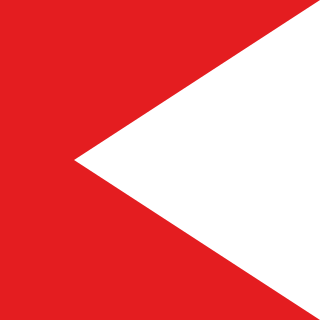
The Deccan States Agency, also known as the Deccan States Agency and Kolhapur Residency, was a political agency of India, managing the relations of the Government of India with a collection of princely states and jagirs in western India.
Kurundwad is a town on the banks of the Panchganga river, 55 km from Kolhapur in the Indian state of Maharashtra.

Gwalior state was a semi-autonomous Maratha state. It was centred in modern-day Madhya Pradesh, arising due to the rise of the Maratha Empire and fragmentation of the Mughal Empire.

Miraj Senior was one of two Maratha princely states during the British Raj: 'Miraj Junior' and Miraj Senior. The two states separated in 1820. It was under the southern division of the Bombay Presidency, forming part of the southern Mahratta Jagirs, and later the Deccan States Agency.

Miraj Junior was one of two Maratha princely states during the British Raj: 'Miraj Senior' and Miraj Junior. The two states separated in 1820. It was under the southern division of the Bombay Presidency, forming part of the southern Mahratta Jagirs, and later the Deccan States Agency.

The Kingdom of Nagpur was an Indian kingdom within the Maratha Confederacy in the 18th and 19th centuries. It came under the rule of the Marathas of the Bhonsle dynasty in the mid-18th century. The city of Nagpur was the capital of the state.

Jamakhandi is a city in Bagalkot district in the Indian state of Karnataka. It was the capital of the former princely state of Jamkhandi. It is located 90 km towards west from district headquarters. It is the first princely state to merge in constituent India based on demand to make Jamkhandi as a district. It is a subdivision of the district. Mudhol, Bilagi, Rabakavi-Banahatti, Teradal and Jamakhandi taluks come under Jamakhandi subdivision.

Kolhapur State or Kolhapur Kingdom (1710–1949) was a Maratha princely State of India, under the Deccan Division of the Bombay Presidency, and later the Deccan States Agency. It was considered the most important of the Maratha principalities with the others being Baroda State, Gwalior State and Indore State. Its rulers, of the Bhonsle dynasty, were entitled to a 19-gun salute – thus Kolhapur was also known as a 19-gun state. The state flag was a swallow-tailed saffron pennant.

Akkalkot State during the British Raj, was a Maratha princely state ruled by the Bhonsle dynasty. The non-salute state came under the Deccan States Agency and was bordered by Hyderabad State and the Bombay Presidency.

Jath State, was one of the non-salute Maratha princely states of Deccan States Agency, one of the former Southern Maratha Jagirs. Jath State and Daphlapur State were the only two states belonging to the Bijapur Agency under the Bombay Presidency, which later became part of the Deccan States Agency.

Bhor State was one of the 9-gun salute Maratha princely states of Deccan States Agency. It was the only state belonging to the Poona Agency under the Bombay Presidency, which became later part of the Deccan States Agency. Along with Akkalkot State, Aundh State, Phaltan State and Jath State, it was one of the Satara Jagirs. The state merged with the newly independent Indian union in 1948.

Sangli State was one of the 11-gun salute Maratha princely states of British India. It was under the Kolhapur-Deccan Residency in the Bombay Presidency, and later the Deccan States Agency.

Dewas Senior was established by Tukoji Rao I Pawar during the Maratha conquest of Central India. It was a 15 Gun Salute Maratha princely state. On 12 December 1818 it became a British protectorate.

Indore State, also known as Holkar State, was a kingdom in India. Its rulers belonged to the Maratha Holkar dynasty. After 1857, Indore became a 19-gun salute princely state under the British Raj.

Kurundvad Junior, also spelt as 'Kurundwad', was of two Maratha princely states during the British Raj: 'Kurundvad Senior' and Kurundvad Junior. The two states separated in 1854 and less than a century later, on 8 March 1948, both states acceded to the Indian Union.

Shahaji II of the Bhonsle dynasty of the Marathas, was the Maharaja of Kolhapur between 1947 and 1949. He was the grandson of Shahu of Kolhapur through his daughter Radhabai and hence nephew of Rajaram III of Kolhapur.
Raja Madhavrao Hariharrao Patwardhan KCIE was the 5th Raja of the princely state of Miraj Jr. of British Raj during the reign (1899–1950). He signed the accession to the Indian Union on 8 March 1948 which ended the separate existence of Miraj Junior state.
The Patwardhan princely state was established by the Patwardhan family, ruling several parts of the Maratha Empire from 1733 till 1948, when it acceded to the Dominion of India. At its peak, various branches of the dynasty controlled several Jagirs within the Maratha Empire, and later became protectorate Princely states in British India.














